
The northern emerald is a middle-sized species of dragonfly first described by Johan Wilhelm Zetterstedt in 1840. The male can be recognised by its pincer-like appendages and its narrow-waisted body. The female has distinctive orange-yellow spots on (only) the third segment of the abdomen.

Somatochlora, or the striped emeralds, is a genus of dragonflies in the family Corduliidae with 42 described species found across the Northern Hemisphere.

The Bulgarian emerald, Corduliochlora borisi, is a species of dragonfly in the family Corduliidae, and the only species in the genus Corduliochlora. It is found in Bulgaria, Greece, and Turkey. Its natural habitat is rivers. It is threatened by habitat loss. The species is named after Boris Marinov. It was formerly treated as a member of the genus Somatochlora.

Somatochlora sahlbergi, the treeline emerald, is a species of dragonfly in the family Corduliidae. It is found at high latitudes across northern Eurasia and North America, and occurs farther north than any other dragonfly.

The brilliant emerald, Somatochlora metallica, is a middle-sized species of dragonfly. It is the largest and greenest of the Somatochlora species; 50–55 millimetres (2.0–2.2 in) long.
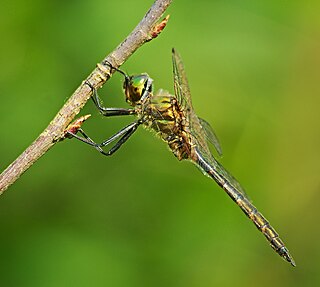
Somatochlora flavomaculata, also called yellow-spotted emerald, is a common species of dragonfly in the family Corduliidae. Its distribution stretches from France to Siberia and Mongolia. It frequents wetlands in its range. The males are known to defend their territory.
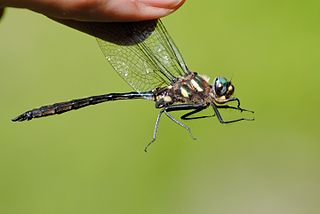
Somatochlora elongata, the ski-tipped emerald or ski-tailed emerald, is a species of dragonfly in the family Corduliidae. It is found in North America.
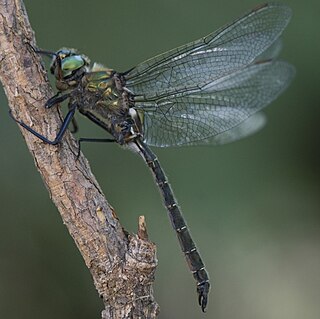
Somatochlora albicincta, the ringed emerald, is a species of emerald dragonfly in the family Corduliidae. It is found in North America.

Somatochlora filosa, the fine-lined emerald, is a species of emerald dragonfly in the family Corduliidae. It is found in North America.

Somatochlora franklini, the delicate emerald, is a species of emerald dragonfly in the family Corduliidae. It is found in North America.
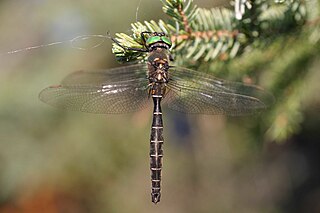
Somatochlora hudsonica, the Hudsonian emerald, is a species of emerald dragonfly in the family Corduliidae. It is found in North America.

Somatochlora cingulata, the lake emerald, is a species of emerald dragonfly in the family Corduliidae. It is found in North America.
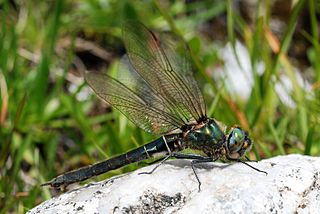
Somatochlora alpestris, or the alpine emerald, is a species of dragonfly from the family Corduliidae. It is found in European highlands, southern Scandinavia, and east to southern Siberia in Asia.

Somatochlora septentrionalis, the muskeg emerald, is a species of dragonfly in the family Corduliidae. It is endemic to Canada, where it is found from Yukon and British Columbia east to Nova Scotia and Newfoundland.
Somatochlora daviesi is a species of dragonfly in the family Corduliidae. It was first described in 1977 based on specimens from Meghalaya, India, and is also known from Nepal and Bhutan. It resembles the east Asian S. dido in its small size and lack of yellow markings on most of the abdomen. Like other species in the genus, S. davisi is predominantly dark metallic brown to green. The formerly recognised Somatochlora nepalensis is now considered to be a synonym of S. daviesi.
Somatochlora dido is a species of dragonfly in the family Corduliidae. It is known from southeastern China and northern Vietnam, but populations in Vietnam may alternatively represent a separate, undescribed, species. S. dido has sometimes been treated as synonymous with S. taiwana from Taiwan, but more recent publications have treated them as separate species. S. shennong is also closely related.
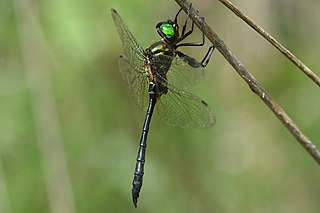
Somatochlora viridiaenea is a species of dragonfly in the family Corduliidae. The species was described in 1858 by American entomologist Philip Reese Uhler based on a female specimen from Hokkaido, Japan. It has also been recorded on Honshu and in eastern Russia.

Somatochlora uchidai is a species of dragonfly in the family Corduliidae. It is native to Japan, China and Russia. It was described in 1909 by German entomologist Friedrich Förster based on specimens from Japan; the name uchidai refers to the Japanese odonate researcher Uchidas from whom Förster received the specimens.
Somatochlora shanxiensis is a species of dragonfly in the family Corduliidae. It is a metallic green to black dragonfly with yellow spots and a total length of 51 to 53 mm. It was described in 1999 based on specimens from Shanxi, China, and has also been recorded in Hubei. It is most similar to Somatochlora graeseri and Somatochlora uchidai.

Somatochlora exuberata is a species of dragonfly in the family Corduliidae. It is found in eastern Russia, northern China, Korea, and Hokkaido, Japan.



















